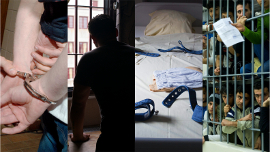About the CPT
The CPT in brief
Download this text in PDF
European Convention for the Prevention of Torture and Inhuman or Degrading Treatment or Punishment
The CPT's Standards
Preventing ill-treatment of persons deprived of their liberty in Europe
The CPT organises visits to places of detention, in order to assess how persons deprived of their liberty are treated. These places include prisons, juvenile detention centres, police stations, holding centres for immigration detainees, psychiatric hospitals, social care homes, etc.
CPT delegations have unlimited access to places of detention, and the right to move inside such places without restriction. They interview persons deprived of their liberty in private, and communicate freely with anyone who can provide information.
After each visit, the CPT sends a detailed report to the State concerned. This report includes the CPT’s findings, and its recommendations, comments and requests for information. The CPT also requests a detailed response to the issues raised in its report. These reports and responses form part of the ongoing dialogue with the States concerned.
The CPT’s full title is the “European Committee for the Prevention of Torture and Inhuman or Degrading Treatment or Punishment”. This highlights two important features: first, it is European, and second, it not only covers “torture”, but also a whole range of situations which could amount to “inhuman or degrading treatment or punishment”.
A system of visits
Visits are carried out by delegations, usually made up of several CPT members, accompanied by staff members of the Committee's Secretariat and, if necessary, by additional experts and interpreters.
CPT delegations carry out visits on a periodic basis (usually once every four years), but additional “ad hoc” visits are carried out when necessary.
The Committee must notify the State concerned that it intends to carry out a visit. After notification, the CPT delegation may go to any place where persons may be deprived of their liberty at any time and without notice.
Co-operation and confidentiality
The principles of co-operation and confidentiality are embodied in the international convention which establishes the CPT.
- Co-operation with the national authorities is at the heart of the CPT’s work, since the aim is to protect persons deprived of their liberty rather than to condemn States for abuses.
- Confidentiality is another characteristic of the work of the CPT: the Committee’s findings, its reports and the governments’ responses are, in principle, confidential. Nevertheless, a great deal of information about the CPT’s work is in the public domain.
Publications
- The State itself may request publication of the CPT’s report, together with its own response. So far, most States have chosen to publish these documents.
- If a State fails to co-operate or refuses to improve the situation in the light of the CPT's recommendations, the Committee may decide to make a public statement.
- In addition, the CPT draws up a general Report on its activities, which is published once a year.
Structure of the CPT
- The CPT's members are independent and impartial experts from a variety of backgrounds, including lawyers, medical doctors and specialists in prison or police matters.
- One member is elected by the Council of Europe’s Committee of Ministers in respect of each State Party. The members serve in their individual capacity (that is, they do not represent the State in respect of which they have been elected). To further guarantee independence, members do not visit the State in respect of which they have been elected.
- The Secretariat of the CPT forms part of the Council of Europe.
Background
- The CPT was set up under the Council of Europe’s “European Convention for the Prevention of Torture and Inhuman or Degrading Treatment or Punishment”, which came into force in 1989.
- It builds on Article 3 of the European Convention on Human Rights which provides that: “No one shall be subjected to torture or to inhuman or degrading treatment or punishment”.
- The CPT is not an investigative body, but provides a non-judicial preventive mechanism to protect persons deprived of their liberty against torture and other forms of ill-treatment. It thus complements the judicial work of the European Court of Human Rights.
Ratifications
- The Convention has been ratified by all the 46 member States of the Council of Europe.
- In addition, the Committee of Ministers of the Council of Europe may invite any non-member State of the Organisation to accede to the Convention.

Preventing torture in Europe
www.cpt.coe.int



